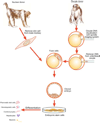Totipotency, pluripotency and nuclear reprogramming
- PMID: 19343304
- PMCID: PMC2752493
- DOI: 10.1007/10_2008_45
Totipotency, pluripotency and nuclear reprogramming
Abstract
Mammalian development commences with the totipotent zygote which is capable of developing into all the specialized cells that make up the adult animal. As development unfolds, cells of the early embryo proliferate and differentiate into the first two lineages, the pluripotent inner cell mass and the trophectoderm. Pluripotent cells can be isolated, adapted and propagated indefinitely in vitro in an undifferentiated state as embryonic stem cells (ESCs). ESCs retain their ability to differentiate into cells representing the three major germ layers: endoderm, mesoderm or ectoderm or any of the 200+ cell types present in the adult body. Since many human diseases result from defects in a single cell type, pluripotent human ESCs represent an unlimited source of any cell or tissue type for replacement therapy thus providing a possible cure for many devastating conditions. Pluripotent cells resembling ESCs can also be derived experimentally by the nuclear reprogramming of somatic cells. Reprogrammed somatic cells may have an even more important role in cell replacement therapies since the patient's own somatic cells can be used for reprogramming thereby eliminating immune based rejection of transplanted cells. In this review, we summarize two major approaches to reprogramming: (1) somatic cell nuclear transfer and (2) direct reprogramming using genetic manipulations.
Figures


Similar articles
-
Reprogramming the genome to totipotency in mouse embryos.Trends Cell Biol. 2015 Feb;25(2):82-91. doi: 10.1016/j.tcb.2014.09.006. Epub 2014 Oct 21. Trends Cell Biol. 2015. PMID: 25448353 Free PMC article. Review.
-
Totipotent-like reprogramming: Molecular machineries and chemical manipulations.Biochim Biophys Acta Mol Cell Res. 2025 Mar;1872(3):119925. doi: 10.1016/j.bbamcr.2025.119925. Epub 2025 Feb 22. Biochim Biophys Acta Mol Cell Res. 2025. PMID: 39993607 Review.
-
Epigenetic reprogramming in the transition from pluripotency to totipotency.J Cell Physiol. 2024 May;239(5):e31222. doi: 10.1002/jcp.31222. Epub 2024 Feb 20. J Cell Physiol. 2024. PMID: 38375873 Review.
-
Reprogramming of two somatic nuclei in the same ooplasm leads to pluripotent embryonic stem cells.Stem Cells. 2013 Nov;31(11):2343-53. doi: 10.1002/stem.1497. Stem Cells. 2013. PMID: 23922292
-
Myc and Dnmt1 impede the pluripotent to totipotent state transition in embryonic stem cells.Nat Cell Biol. 2019 Jul;21(7):835-844. doi: 10.1038/s41556-019-0343-0. Epub 2019 Jun 17. Nat Cell Biol. 2019. PMID: 31209294 Free PMC article.
Cited by
-
Lipid-based nanoparticles for drug delivery in Parkinson's disease.Transl Neurosci. 2024 Dec 3;15(1):20220359. doi: 10.1515/tnsci-2022-0359. eCollection 2024 Jan 1. Transl Neurosci. 2024. PMID: 39654878 Free PMC article. Review.
-
Totipotency: what it is and what it is not.Stem Cells Dev. 2014 Apr 15;23(8):796-812. doi: 10.1089/scd.2013.0364. Epub 2014 Feb 12. Stem Cells Dev. 2014. PMID: 24368070 Free PMC article.
-
Stem Cell-Based Therapies: What Interventional Radiologists Need to Know.Semin Intervent Radiol. 2021 Nov 24;38(5):523-534. doi: 10.1055/s-0041-1736657. eCollection 2021 Dec. Semin Intervent Radiol. 2021. PMID: 34853498 Free PMC article. Review.
-
Stem cells in microfluidics.Biomicrofluidics. 2011 Mar 30;5(1):13401. doi: 10.1063/1.3528299. Biomicrofluidics. 2011. PMID: 21522491 Free PMC article.
-
Stem cells' guided gene therapy of cancer: New frontier in personalized and targeted therapy.J Cancer Res Ther (Manch). 2014;2(1):22-33. doi: 10.14312/2052-4994.2014-4. J Cancer Res Ther (Manch). 2014. PMID: 24860662 Free PMC article.
References
-
- Nicholas J, Hall B. Experiments on developing rats: II. The development of isolated blastomeres and fused eggs. J Exp Zool. 1942;90:441–459.
-
- Johnson WH, et al. Production of four identical calves by the separation of blastomeres from an in vitro derived four-cell embryo. Vet Rec. 1995;137(1):15–16. - PubMed
-
- Willadsen SM, Polge C. Attempts to produce monozygotic quadruplets in cattle by blastomere separation. Vet Rec. 1981;108(10):211–213. - PubMed
-
- Tarkowski AK. Experiments on the development of isolated blastomers of mouse eggs. Nature. 1959;184:1286–1287. - PubMed
-
- Mitalipov SM, et al. Monozygotic twinning in rhesus monkeys by manipulation of in vitro-derived embryos. Biol Reprod. 2002;66(5):1449–1455. - PubMed
Publication types
MeSH terms
Grants and funding
LinkOut - more resources
Full Text Sources
Other Literature Sources
Research Materials

